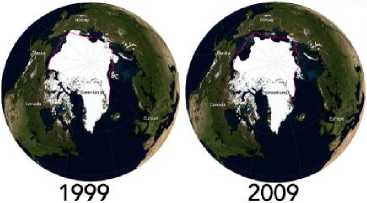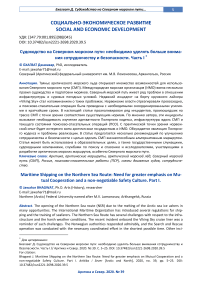Судоходство на северном морском пути: необходимо уделять больше внимания сотрудничеству и безопасности. Часть I
Автор: Бхагват Джавахар
Журнал: Арктика и Север @arcticandnorth
Рубрика: Социально-экономическое развитие
Статья в выпуске: 39, 2020 года.
Бесплатный доступ
Таянье арктического морского льда открывает множество возможностей для использования Северного морского пути (СМП). Международная морская организация (ИМО) ввела несколько правил судоходства и подготовки моряков. Северный морской путь имеет ряд проблем в отношении инфраструктуры и суровых погодных условий. Недавний инцидент на борту круизного лайнера «Viking Sky» стал напоминанием о таких проблемах. Норвежские власти отреагировали превосходно, а поисково-спасательная операция была проведена с необходимыми скоординированными усилиями в кратчайшие сроки. В настоящей статье проанализирован ряд инцидентов, произошедших на трассе СМП с точки зрения соответствия существующим нормам. По мнению автора, эти инциденты вызывают необходимость изучения адекватности Полярного кодекса, инфраструктуры вдоль СМП и текущего состояния поисково-спасательных операций (ПСО). С практической точки зрения норвежский опыт будет интересен всем арктическим государствам и ИМО. Обсуждается эволюция Полярного кодекса и проблемы реализации. В статье предлагается несколько рекомендаций по улучшению сотрудничества и безопасности с целью сделать СМП жизнеспособным альтернативным маршрутом. Статья может быть использована в образовательных целях, а также государственными служащими, судоходными компаниями, службами по поиску и спасению и исследователями, участвующими в разработке арктических морских маршрутов, особенно Северного морского пути.
Арктика, арктические маршруты, арктический морской лёд, северный морской путь (смп), Россия, поисково-спасательные работы (пср), схемы движения судов, сотрудничество
Короткий адрес: https://sciup.org/148310658
IDR: 148310658 | УДК: [347.79:001.895](98)(045) | DOI: 10.37482/issn2221-2698.2020.39.5
Текст научной статьи Судоходство на северном морском пути: необходимо уделять больше внимания сотрудничеству и безопасности. Часть I
Cеверный полюс
Полярный круг
Полюс недоступности
США
Российская Федерация
Cеверный магнитный полюс
Канада
Russian
Federation
Bathymetry (meters)
Гренландия
Батиметрия (метров)
200 м
500 м
2500 м
4000 м
5000 м
Исландия
Northwest Passage Northeast Passage
Фарерские острова
Швеция
морская миля
Северо-западный проход Северо-восточный проход Северный морской путь
Дания
Финляндия
Норвегия
Рис. 1. Страны, имеющие выход в арктические моря, смогут сократить морские маршруты из-за таяния льда 2.
Арктика, несомненно, один из наиболее быстро меняющихся регионов на Земле, а снижение уровня морского льда экспоненциально расширяет возможности для морской деятельности в ранее недоступных районах, таких как Северный морской путь (СМП) и Северозападный проход [1, Silber G.K., Adams J.D., с. 1], хотя темпы увеличения их использования могут быть не такими большими, как ожидали СМИ.3 В соответствии с Федеральным законом Российской Федерации «О внутренних морских водах, территориальном море и прилегающей зоне Российской Федерации» (Правительство Российской Федерации, 1998 г.) СМП признан историческим национальным транспортным маршрутом России в Арктике.

Рис. 2. Графическое изображение Северного морского пути и маршрута через Суэцкий канал 4.
В центре внимания настоящей статьи находится СМП, поскольку его использование может на 40% сократить расстояние между Азией (Иокогама) и Европой (Роттердам) в сравнении с традиционным маршрутом через Суэцкий канал [2, Liu M., Kronbak J., с. 434]. Хотя ожидается, что объём перевозок по арктическим маршрутам увеличится в течение следующих нескольких десятилетий, по ряду причин немногие ожидают, что он будет конкурировать с традиционными морскими торговыми маршрутами [3, Verny J., Grigentin C., с. 107– 117]. Кроме того, сокращение расстояния на 40% или почти на 4 000 морских миль не означает финансовой экономии на 40%. Судоходные компании должны обратить внимание на более высокие затраты на строительство судов соответствующего ледового класса, обеспечение специальной подготовки членов экипажа, нерегулярных и замедленных скоростей прохождения маршрута, трудностей с навигацией и высоких рисков, обязательных сборов за ледокольную проводку, высоких страховых тарифов ввиду тяжёлых погодных условий и отсутствия средств безопасности на маршруте [2, Liu M., Kronbak J., с. 434–444].
Пусан
Циндао Шанхай
Расстояние от Антверпена до Шанхая по Северному морскому пути: 8 366 морских миль. Заполненная льдом вода на расстоянии: 1 214 морских миль
Гамбург Роттердам Антверпен
Antwerp to Shanghai via the Northern Sea Route: 8,366 nm
Гамбург Роттердам Антверпен
Hamburg
Rotterdam
Antwerp
Qingdao
Shanghai
Ice filled water distance: 1,214 nm
Сингапур Гонконг
Гонконг
Сингапур
Hamburg Rotterdam
Antwerp
Singapore Hong Kong
Hong Kong Singapore
Busan , Qingdao Shanghai
Hamburg to Busan distance via the Suez Canal Route: 11,784 nm
Расстояние от Гамбурга до Пусана по маршруту через Суэцкий канал: 11 784 морских мили
Пусан Циндао Шанхай
Рис. 3. Дистанционное преимущество Северного морского пути по отношению к маршруту Суэцкого канала 5.
Из отчёта Арктического совета «Оценка арктического морского судоходства за 2009 год»: «В Арктике наблюдается общая нехватка морской инфраструктуры, за исключением районов вдоль норвежского побережья и северо-запада России, по сравнению с другими морскими регионами мира с высокой концентрацией движения судов. Существуют пробелы в гидрографических данных для значительных частей основных маршрутов судоходства, важных для обеспечения безопасной навигации. Кроме того, для безопасной работы в Арктике необходим тот же набор метеорологических и океанографических данных, продуктов и услуг, что и для других океанов, а также всеобъемлющая информация о морском льде и айсбергах. За исключением ограниченных районов Арктики существует нехватка средств реагирования на чрезвычайные ситуации для спасения жизней и уменьшения загрязнения. Существуют серьёзные ограничения для радиосвязи и спутниковой связи, а также недостаточно систем контроля и управления движением судов в покрытых льдом водах» [4, Arctic Council, с. 6].
России необходимо модернизировать физическую инфраструктуру Северного морского пути (СМП), которая атрофировалась после распада СССР в 1991 г. Например, из всех арктических российских морских портов только Дудинка может принимать суда круглый год.
Все порты нуждаются в дноуглубительных работах, чтобы принимать современные крупнотоннажные суда [5, Tianming G., Erokhin V., с. 2]. Флот, проводящий дноуглубительные работы в российской Арктике, состоит всего из шести судов, в том числе пяти самоходных и одного самоходного земснаряда. Их средний возраст — более 40 лет. Малое количество судов и их износ подтолкнул Россию к поискам иностранных подрядчиков, преимущественно из Нидерландов и Бельгии. Аналогичным образом улучшение навигационных, метеорологических и поисково-спасательных служб (ПСС) требует существенных инвестиций. У России нет финансовых средств, чтобы выполнить все эти задачи в одиночку. Иностранные инвесторы, в том числе из Азии, за исключением Китая, проявляют ограниченный интерес [6, Arctic Centre, с. 41]. Во-вторых, Арктика богата природными ресурсами, но их масштаб и коммерческая выгода от их разработки остаются под вопросом. Добыча арктических ресурсов технически сложна и затратна. Использование энергии и минеральных ресурсов в других частях мира, таких как Ближний Восток, Африка и Южная Америка, намного дешевле, особенно если стоимость нефти упадёт ниже 50 долларов за баррель; существующие судоходные пути, которые проходят через Юго-Восток в Северо-Восточную Азию, имеют несколько преимуществ.
В-третьих, и, возможно, это станет самым главным для Сингапура — крупного перевалочного узла, экономика контейнерных перевозок по СМП является неоптимальной. Для улучшения эффекта масштаба и, следовательно, увеличения прибыли, судоходные компании инвестируют в более крупные суда; контейнеровозы нового поколения имеют грузоподъёмность более 18 000 TEU. Но из-за ограничений, налагаемых мелкими водами и узкими проливами в некоторых частях СМП, максимальная вместимость контейнеровозов, которые могут использовать этот маршрут, составляет около 4 000 TEU 6. Таким образом, контейнеровоз в состоянии пройти СМП быстрее, чем маршрут Суэц-Малакка; стоимость контейнера может быть намного выше [7, Carmel S.M., с. 38–41]. Кроме того, суровые и непредсказуемые погодные условия СМП влияют на выполнение графика перевозок, от которого зависит прибыль от доставки контейнеров. Отсутствие крупных портов сокращает возможности торговли по пути. Тем не менее, политическая нестабильность в Персидском заливе и на Ближнем Востоке может побудить страны Северо-Восточной Азии, включая Северную Корею, сотрудничать с Россией в развитии СМП. Китай официально закрепил своё участие в освоении Арктики, включив северные морские маршруты в сеть морских переходов Инициативы «Belt and Road» (BRI) [8, Zhang X., с. 370–395]. Фундаментальной частью будущего Полярного шёлкового пути является СМП, который проходит вдоль арктического побережья России и обеспечивает более лёгкий доступ для межконтинентального судоходства в полярных водах [5, Tianming G., Erokhin V., с. 2]. Китайские эксперты утверждают, что по технологическим, экономическим и политическим причинам Россия не в состоянии наращивать строительство кораблей и морской техники настолько, чтобы поддерживать растущий объём грузоперевозок в Арктике [5, Tianming G., Erokhin V., с. 11]. Северо-Восточная Азия уже стала регионом, имеющим большое экономическое значение. В частности, это справедливо для Китая, даже с учётом нынешней опасной геополитической ситуации: объявленную торговую войну, угрозу для нефтедобывающих стран Западной Азии, влияние «пандемии COVID-19» и угрозу санкций. СМП, хотя и предполагает большие финансовые затраты и создание необходимой инфраструктуры, является более безопасным альтернативным и стратегическим маршрутом, который должен быть разработан вместе с сухопутным маршрутом через Центральную Азию и Евразию. Поэтому у Китая есть возможность внести свой вклад в развитие технологий и инвестиций, а также выиграть от сотрудничества с Россией в этой сфере [5, Tianming G., Erokhin V., с. 11]. Следовательно, поскольку морской лёд продолжает отступать, объём перевозок по СМП несомненно будет расти, особенно в Северо-Восточной Азии. Но по причинам, указанным выше, СМП вряд ли сможет в ближайшем будущем конкурировать с морскими маршрутами с большим трафиком, такими как Суэц-Малакка.
Осознавая это, а также другие препятствия, на Международном арктическом форуме в Санкт-Петербурге в апреле 2019 г. президент Владимир Путин пригласил иностранных инвесторов помочь в совместном строительстве транспортных узлов СМП в Мурманске и Петропавловске-Камчатском. Президент также поручил правительству составить планы по налоговым льготам, которые будут способствовать развитию арктического региона 7. В феврале 2020 г. премьер-министр России Михаил Мишустин объявил о новых законодательных инициативах для развития Арктики. Любая компания или предприниматель, зарегистрированный в арктическом регионе, получит ряд налоговых льгот, если инвестирует не менее 10 млн рублей в любую территорию арктической зоны 8. Пакет инициатив также включает нулевую ставку налога на добычу полезных ископаемых на 12 лет и льготный налоговый режим в размере 5% на 15 лет для стимулирования добычи нефти на континентальном шельфе 9. Кроме того, предусмотрены меры для поддержки строительства портов, промышленных предприятий и других секторов, важных для развития Арктики, а также нулевой подоходный налог в течение 10 лет, снижение НДС до нуля для услуг по перевозке экспортных товаров и их ледокольную поддержку. Предполагается, что эти меры должны поспособствовать дальнейшему развитию СМП 10.
Аляска
Российская
Федерация
Канада
Северный Ледовитый океан
Северный полюс
Северный морской путь
Гренландия
Баренцево море
СевероЗападный проход
Мурманск Киркенес
Исландия
Норвежское море
Роттердам
Норвегия
Швеция
Финляндия
Рис. 4. Самые быстрые навигационные маршруты для судов, стремящихся пересечь Атлантический океан в течение сентября, в настоящее время благоприятствуют СМП, который проходит вдоль береговой линии России (Труды Национальной академии наук) [9, ABS, с. 2].
За этим последовало ещё более значимое событие — выпуск документа «Основы государственной политики России в Арктике до 2035 года», подписанного президентом Владимиром Путиным 11. В документе говорится, что развитие СМП как конкурентоспособного национального транспортного сообщения России на мировом рынке является одним из основных национальных интересов Российской Федерации в Арктике 12. В нём также указывалось, что несоблюдение сроков создания инфраструктуры СМП, строительства судов ледового класса, спасательных и ледокольных флотов отмечается как одна из основных угроз национальной безопасности 13. Также предусматриваются работы по созданию интегрированной инфраструктуры СМП, гидрометрической, гидрографической и навигационной системы поддержки для судов, проходящих СМП 14. Базовая инфраструктура создаётся в рамках федерального проекта «Северный морской путь», основной целью которого является увеличение грузопотока до 80 млн т к концу 2024 г. 15. Общий объём финансирования проекта до конца 2024 г. предполагается в размере 735 млн руб. 16. Проект, несомненно, впечатляет своей концепцией, но ещё не известно, будут ли выделены средства, особенно при низких ценах на нефть и текущем экономическом кризисе из-за COVID-19.
Правительство также изучает концепцию транспортного коридора для Северного морского пути с целью облегчения комплексной работы над инфраструктурой арктических портов, развития ледокольного флота и создания сети железных и автомобильных дорог во всех регионах Арктики 17. Это означает строительство самых мощных ледоколов в мире (пять судов проекта 22220), вспомогательный и спасательный флот, а также строительство Северной широтной железной дороги 18. Всё это также позволило бы арктической логистике не ограничиваться СМП, который простирается от Карских ворот на западе до Берингова пролива на востоке, как определено международным законодательством 19. Корпорация развития Камчатки (КРКК) и Приморская универсальная погрузочно-разгрузочная компания (Приморский КТК) подписали первоначальное соглашение в рамках Международного арктического форума 9 апреля в Санкт-Петербурге. Соглашение предусматривает строительство контейнерного терминала под Санкт-Петербургом и ещё одного на Камчатке, которые будут завершены к 2022 и 2024 гг. соответственно. Кроме того, можно было бы построить аналогичный объект на Кольском полуострове рядом с Мурманском 20. ООО «Прибежный» начало строительство перегрузочного комплекса в Лиинахамари с акцентом на арктическую логистику 21. Границы Мурманского порта были изменены распоряжением Правительства России от 31 марта 2020 г. с целью разгрузить морской перевалочный комплекс для сжиженного природного газа (СПГ) 22. Морское управление Норвегии выдало разрешение на транспортировку СПГ, произведённого Новатеком, по схеме «из стороны в сторону» (судно – судно) на шесть лет 23. Предполагалось, что погрузка будет проходить в Мурманской области, в районе острова Кильдин 24. «Новатэк» сообщил о завершении строительства якорных причалов рядом с островом Кильдин 25. Предполагается также создание транспортно-логистического узла на Сахалине, который будет включать модернизацию Корсаковского порта и возможность строительства современного перевалочного порта в Макаровском районе 26.

Рис. 5. Карта с указанием приблизительного маршрута и расположения перевалочных узлов 27.
Первый транзитный рейс по СМП состоялся летом 2010 г. Его совершил «Nordic Barents», сухогруз IA ледового класса, под флагом Гонконга, но принадлежащий норвежской судоходной компании «Tschudi» [10, Franckx E., Boone L., с. 190]. Корабль покинул норвежский порт Киркенесс с 41 000 т железорудного концентрата, который должен был быть выгружен через 12 дней в Китае. Судно не останавливалось в российском порту для погрузки или разгрузки [10, Franckx E., Boone L., с. 190]. Таким образом, это был первый случай транзитного прохода через СМП, совершённый судном под иностранным флагом для международных коммерческих целей. Однако ещё два судна «MV Beluga Fraternity» и «MV Beluga Foresight» прошли через СМП с помощью ледокола «50 лет Победы» в конце августа — сентябре 2009 г. 28. «MV Nordic Barents» в сопровождении российских атомных ледоколов завершил прохождение СМП за девять дней [11, Ostreng W. et al., с. 184–185]. Поэтому очевидно, что увеличение трансарктического судоходства вдоль СМП принесёт пользу портам Северо-Восточной Азии и может отвлечь трафик от традиционных перевалочных узлов, таких как Сингапур. По предварительным оценкам, судоходство в регионе обещает увеличить торговлю Китая с европейскими странами с 10,95% до 20% и способствовать обеспечению энергетической безопасности за счёт диверсификации маршрутов поставок топлива [12, Kobzeva M., с. 6]. Япония 29 (крупнейший в мире потребитель СПГ) и Германия, близкие партнёры США по обеспечению безопасности, продолжают свои энергетические связи с Россией, несмотря на угрозу санкций США. В ответ на замечание президента Трампа в июле 2018 г. «Насколько я понимаю, Германия находится в плену у России, потому что она получает от России так много энергии» канцлер Ангела Меркель дипломатично ответила: «Мы можем разрабатывать собственную политику и принимать собственные решения» 30. Вопросы, касающиеся СМП, было бы целесообразно изучить с помощью двух тематических исследований, т.к. представляется возможным с их помощью обосновать вышеупомянутые проблемы, особенно безопасность судоходства.
Инцидент 1. «Viking Sky»
Исследование «Арктический туризм: реалии и возможности», опубликованное в «Arctic Yearbook 2014», выявило возможные проблемы и решения для арктического судоходства. Исследование представило Арктику как территорию Норвегии, включая г. Тромсё [13, Maher P., с. 6]. Там наблюдалась растущая тенденция увеличения количества больших пассажирских судов, работающих в арктических водах. Базовая поисково-спасательная инфраструктура и минимальные гидрографические данные в этих районах по-прежнему вызывают беспокойство в связи с намерением отрасли круизного судоходства расширяться в этих территориях [14, Brigham L., с. 179]. В 2019 г., в ходе круиза, сотни пассажиров, многие из которых являлись пожилыми людьми, были эвакуированы с круизного лайнера «Viking Sky» у норвежского побережья. Инцидент произошёл непосредственно за пределами арктических вод, как определено в Полярном кодексе. Однако видится актуальным его обсуждение в ракурсе устойчивого роста арктического туризма. В отчёте о состоянии судоходства в Арктике говорится, что в связи с ростом арктического морского туризма в 2019 г. в районе действия Полярного кодекса зафиксировано 73 круизных лайнера, а в 2018 — 65 31. Корабль попал в шторм, двигатели перестали работать. Судно было новым и эксплуатировалось всего два года. На борту находились 915 пассажиров и 458 членов экипажа. «Viking Sky» принимал пассажиров рейса «В поисках северного сияния», начинающегося и заканчивающегося в Тилбе-ри в Эссексе. Судно отплыло из Тромсё 21 марта 2019 г. и должно было прибыть в Тилбери 26 марта. Несмотря на прогноз погоды, отплытие состоялось. Наконец, в 14:00 22 марта, после того как судно было обесточено и утратило тягу, оно начало дрейфовать по направлению к суше (скалы Хустадвики). Согласно заявлению компании, «Viking Sky» потерял мощность двигателя у берегов Норвегии около Молде. Далее была объявлена чрезвычайная ситуация, и пассажиры отправились в свои спасательные станции. Согласно источникам компании, в это время пришла огромная волна, которая сбивала пассажиров с ног, разбила большое стекло, чем вызвала травмы 32.
11.07.2018.
обращения:
Поиск и спасение
Пассажиры были эвакуированы с помощью вертолёта, который доставлял людей группами по 15–20 человек в город Молде. К 10:30 24 марта было эвакуировано 479 пассажиров. Примерно 20 человек, которые получили травмы, прошли лечение в медицинских центрах Норвегии. Уместно упомянуть, что во время чрезвычайной ситуации «Viking Sky» находилось в 200 морских милях к югу от Полярного круга. Эта случайная позиция судна определённо помогла поисково-спасательным операциям. После завершения операции по поиску и спасению, в дополнение к благодарности норвежской администрации, которая проделала блестящую работу, компания заявила, что «мы также хотели бы поблагодарить местных жителей, которые на протяжении всего процесса оказывали посильную помощь...». Во время другого инцидента с судном этой же компании пассажиры «Viking Idun» были выброшены из своих кроватей рано утром 1 апреля 2019 г. после того, как их судно столкнулось с нефтяным танкером. Речной круиз из Антверпена в Гент перевозил 171 пассажира по 10дневному маршруту через Бельгию. К счастью, никто не был серьёзно ранен, и не произошло утечки нефтепродуктов, так как повреждение оказалось выше ватерлинии 33.
Анализ: инцидент с «Viking Sky»
Несмотря на то, что власти, несомненно, проведут подробное расследование инцидента, серьёзным поводом для беспокойства является отказ двигателя двухлетнего корабля. Причиной могла стать неисправная работа двигателя либо отсутствие знаний у экипажа при работе в аварийной ситуации. 25 марта 2019 г. Норвежское морское управление (Sjofartsdirektoratet) начало расследование причин, по которым вышло из порта в такую погоду. Также было проведено техническое исследование о неисправности двигателей и организации спасательной операции. Официально неисправность двигателей была вызвана низким давлением масла. Уровень смазочного масла в резервуарах находился в установленных пределах, но был относительно низким во время перехода через Хустадвику. Масляные баки оснащены сигнализацией уровня, которая не сработала. Сильные колебания моря в Ху-стадвике вызвали сбой в работе насосов. Сработала тревога из-за низкого уровня смазочного масла, что в свою очередь привело к автоматическому отключению всех 4 двигателей 34. 26 марта Норвежское морское управление предоставило «Viking Ocean Cruises» разрешение для «Viking Sky» отправиться в Кристиансунн для срочного ремонта.
Все подобные двигатели и их контрольное оборудование, установленные на различных судах этого типа, были проверены на пригодность. Кроме того, решение о выходе из порта, несмотря на предупреждение о штормовых ветрах и волнах, является ещё одной областью, требующей изучения. Хотя инцидент произошёл за Полярным кругом, его близость к арктическим водам, присутствие 915 пассажиров и 458 членов экипажа и почти новый круизный лайнер выявляют необходимость изучения адекватности Полярного Кодекса и текущего состояния поисковых и спасательных операций в Арктике. Норвежское морское управление ещё не опубликовало отчёт о расследовании этого инцидента 35.
Investigation of accidents
Извлечённые уроки

Lessons learned
The Norwegian Maritime Authority regularly publishes lessons learned from marine incidents and accidents.


Норвежское Морское Управление
Международная
морская организация — извлечённые
Предупрежде-
ния по технике
безопасности
Комиссия по рас-
The Norwegian Maritime Authority
The Norwegian Maritime Authority surveys Norwegian and foreign vessels in Norwegian waters pursuant to the Maritime Safety Act
следованию
уроки несчастных случаев Норвегии

Tne Police
Upon suspicion of legal offences in connection with marine accident.


Международный форум исследователей морских аварий
The Accident Investigation Board Norway (AIBN) The AIBN is a public committee of
Marine Accident Investigators' International Forum

Полиция
Оповещения по электронной почте
Lessons learned
< Investigation of accidents
Извлечённые

PUBLISHED; 05/08/2016
The Norwegian Maritime Authority regularly publishes lessons learned from marine incidents and accidents.
The Norwegian Maritime Authority
The police
The Accident Investigation Board
Norway (AlBN)
updates
Administer my alert settings
уроки
Lessons learned - laser incident
06 01-2020 | 13:25
Navigation bridge exposed to powerful green laser light or bright light In the fairway.
Marine Accident Investigators'
International Forum {MAIIF)
Lessons Learned - Contamination of Cargo implicating injury of personnel
26.01.2016 | 14:32
A moored offshore vessel was going to load brine, i e. Calcium Chloride Brine (CaCI2) and Sodium Chloride Brine (NaCI). each of 50 m3, into the brine
Learning from incidents - Engine increased speed uncontrolled 07.12.2015 | 11:32
A vessel that should go to a dock had reduced speed by setting the control levers to the neutral position.
Рис. 6. Сайт Норвежского морского управления 36.
Инцидент 2. «Борис Вилькицкий»
Эти факты являются грубыми нарушениями Правил судоходства в водах СМП: 9 апреля 2018 г. торговое судно «Борис Вилькицкий» вошло в воды СМП, пройдя мыс Желания с помощью ледокола «Таймыр», нарушая Правила судоходства. Карские ворота, расположенные между островом Вайгач и островом Новая Земля, являются наиболее сложными для прохождения из-за ледового обмена с Карским морем. В основном к концу зимы преобладает паковый лёд первого года, толщина которого достигает 0,12–0,14 м. Ледяные поля в Карских воротах часто сжимаются и торосят, что чрезвычайно усложняет ледокольную про- водку. В этом регионе ледовые потоки периодически дрейфуют с высокой скоростью, что может привести к отключению даже атомных ледоколов [15, Mayorova et al, с. 117–128].

Рис. 7. Инцидент «Бориса Вилькицкого». Администрация СМП 37.
Согласно западному источнику, между Росатомом и Минтрансом России продолжалась борьба за контроль над Северным морским путём 38. Однако согласно российским источникам, это скорее борьба между Администрацией СМП (подконтрольной Минтрансу) и «Новатэк», который испытывает нехватку судов с высоким ледовым классом для развития своих проектов на полуострове Ямал 39. Однако, как сообщается, противостояние усилилось в апреле 2018 г., когда судно СПГ «Борис Вилькицкий», управляемое «Dynagas LNG Partners» (Кипр), не зарегистрированное в арктическом государстве, вошло в СМП, несмотря на повреждение одного из трёх его двигателей.
Неисправность снизила ледовые возможности судна с Arc7 до Arc4 и сделала незаконным доступ судна на маршрут 40. Для работы в Карском море летом и осенью судно должно быть как минимум класса Arc5. Судам класса Arc4 разрешено самостоятельное плавание в лёгких и умеренных ледовых условиях. Зимой и весной — Arc8. Независимая эксплуатация судов класса Arc5 и Arc6 разрешена только при лёгких ледовых условиях, а Arc7 — при лёгких и умеренных ледовых условиях [5, Tianming G., Erokhin V., с. 9].
-
37 ФГБУ «Администрация Северного Морского Пути». Суда-нарушители Правил плавания в акватории СМП. 12.04.2018. URL: http://www.nsra.ru/ru/archive_non_compliant_vessels.html (дата обращения: 01.01.2019).
-
38 Malte H. Shipping Safety Violation Escalating Internal Conflict Russia’s Northern Sea Route, 04 May 2018. URL: https://www.arctictoday.com/shipping-safety-violation-escalating-internal-conflict-russias-northern-sea-route/(дата обращения: 15.04.2019).
-
39 Gunnarsson B. Ship Traffic Analysis on the Northern Sea Route and Development of Arctic Transportation and Logistics. Lecture to the International Ph.D. School. САФУ, Архангельск, 05.04.2019.
-
40 Севморпуть дошел до Кремля. Коммерсант, 03 May 2018. URL: https://www.kommersant.ru/doc/3619227 (дата обращения: 15.04.2019).
Чиновники администрации СМП узнали о повреждении судна только тогда, когда оно столкнулось с трудностями при навигации по тяжёлому льду по пути в порт Сабетта в сопровождении ледокола «Росатомфлота» (дочернее предприятие Росатома) «Таймыр». После прибытия судна в Сабетту официальные лица обнаружили дополнительные нарушения, в том числе отсутствие точных ледовых карт и отсутствие необходимого опыта ледовой навигации у капитана и экипажа 41. «Борис Вилькицкий» оставался в порту более недели, прежде чем ему разрешили уйти после вмешательства администрации президента 42. Росатом представил этот инцидент как свидетельство бюрократического подхода Минтранса к управлению СМП, выставляя себя ответственным субъектом, заботящемся о коммерческих интересах России [16, Sergunin A., Konyshev V., с. 6]. В данной ситуации президент Путин поддержал Росатом и раскритиковал Минтранс во время встречи с депутатами Госдумы. Он заявил: «Га- зовозам не разрешается заходить в порт под надуманными предлогами, тогда им не дают уйти. Этот момент будет рассматриваться отдельно» 43.
Нарушение ледовой обстановки

-
■ Violation of ice conditions
-
■ Operating Without Permit
-
■ Operating Outside Permit Area
-
■ Procedural Violations
Работа без разрешения
Работа за пределами разрешительной зоны
Процедурные нарушения
Рис. 8. Нарушение правил безопасности на трассе СМП: Январь — Октябрь 2017 44.
О других нарушениях безопасности сообщалось и на веб-сайте Северного морского пути в течение 2016–2017 гг., что можно считать позитивным моментом 45. По словам аналитика Мальте Хамперта, нарушения показали резкий рост в 2017 г., как показано на рис. 8 46. Но это также может быть связано с резким увеличением трафика по СМП по сравнению с предыдущими годами. Грузопоток в арктических морях неуклонно растёт, составив 54,3 млн т за 9 месяцев 2017 г., до 66,9 млн т в 2018 г. и до 78,6 млн т в 2019 г. [17, Teslya A., Gutman S., с. 3]. Тем не ме- нее на сайте не отображаются какие-либо записи за 2018 г., кроме инцидента с «Борисом Виль-кицким», и ничего не сказано про 2019 г. 47. Предполагается, что нарушений безопасности не наблюдалось и не сообщалось, хотя западные наблюдатели уже отмечали, что плохая реклама после инцидента с «Борисом Вилькицким» и увеличение числа нарушений безопасности, о которых говорилось в 2017 г., могло привести к ограничению размещения информации на вебсайте 48. На сайте также не указаны какие-либо действия, предпринятые против нарушений и для предотвращения повторения инцидентов, опубликованные ранее 49.


Ключевые проливы в российских арктических морях.
-
A. Маточкин шар
-
B. Карские Ворота
-
C. Югорский Шар
-
D. пролив Шокальского
-
Е. пролив Бориса Вилькицкого F. пролив Санникова G. пролив Дмитрия Лаптева
-
H. пролив Лонга
Чукотское море
Берингово море

Северный
Восточно-
Сибирское
Северный
Ледовитый
океан
Море Лаптевых
Северная земля
Рис. 9. Карта СМП [9, ABS, с. 5].

Баренцево море
Новая земля
Карское море
Россия
Длина Северного морского пути варьируется на расстоянии от Карских ворот до пролива Дежнева и составляет приблизительно от 2700 морских миль (пути с высокими широтами) до 3 500 морских миль (пути вдоль побережья) в зависимости от конкретного маршрута, ледовой обстановки, погодных условий и других факторов [5, Tianming G., Erokhin V., с. 6– 7]. Следует отметить, что после этого инцидента Министерство транспорта разработало законопроект (всё ещё находящийся на рассмотрении), в котором предлагается разделить СМП на 28 участков (вместо 7) для изучения и предоставления более точных данных о региональных ледовых условиях, которые позволили бы расширить навигацию через СМП для
судов с более низким ледовым классом. Законопроект разрешил бы судам Arc4 и Arc5 заходить в некоторые районы СМП (в частности, в Карское море и в район Сабетты, что важно для Новатэка), где им запрещено находиться в соответствии с действующими правилами 50.
Действующие правила регулирования для СМП, вступившие в силу 17 января 2013 г., предусматривают, что существует семь больших районов СМП с различными климатическими и ледовыми условиями, а правила разрешения на вход в каждую из этих областей различаются в зависимости от ледового класса, ледовой обстановки, погодных условий и времени года 51. Видимое облегчение ледовой обстановки в Арктике не связано с улучшением навигационных условий [5, Tianming G., Erokhin V., с. 8]. Динамические силы, воздействующие на лёд, а также айсберги представляют серьёзную опасность для навигации [5, Tianming G., Erokhin V., с. 8]. Таким образом, в некоторых частях Северного Ледовитого океана деформированный однолетний лёд может достигать 5–7 м в толщину, что усложняет или почти блокирует проход морских судов, особенно в узких проливах, где течения давят на лёд, таким образом увеличивая его толщину [5, Tianming G., Erokhin V., с. 8]. Дрейфующий лёд — ещё одна опас- ность для судоходства. Из-за уменьшения толщины ледяного покрова и площади лёд становится более подвижным, скорость дрейфа увеличивается, а поведение льда становится более динамичным и менее предсказуемым [5, Tianming G., Erokhin V., с. 8]. Многие эксперты придерживаются мнения, что в течение всего года динамически меняются условия обледенения [18, Zagorski A., с. 225]. В настоящее время специалисты из Государственного университета морского и внутреннего судоходства им. Адмирала Макарова в Санкт-Петербурге пытаются разработать новый метод прогнозирования ледовой обстановки в Карском море, являющейся частью СМП 52.
Администрация СМП выдаёт разрешение на основании сертификации, предоставленной судном, без фактического досмотра [18, Zagorski A., с. 225]. 3 апреля 2020 г. атомный ледокол «Вайгач» успешно завершил аварийную буксировку танкера «Варзуга» (бункерная компания ОАО «Архангельск») в северо-восточной части Баренцева моря. Буксировка началась 29 марта в Обской губе при помощи другого атомного ледокола «50 лет Победы», поскольку танкер, находившийся в балласте, имел вышедший из строя двигатель «Азипод». Корабль мог дрейфовать на берег из-за ледовой обстановки, и поэтому, по словам Дмитрия Лобусова, капитана ледокола «50 лет Победы», «нужно было быстро приступить к работе» 53. Следовательно, после анализа инцидентов, произошедших на трассе СМП, с учётом мнений экспертов и первостепенной необходимости сохранения хрупкой арктической среды, по мнению автора, преждевременно рассматривать изменения, основанные на экономических интересах. Российские власти должны рассмотреть возможность внесения поправки после десяти лет безопасной эксплуатации судов в водах СМП, т.е. не раньше 2023 г. Нет необходимости говорить, что мнения моряков, в том числе судов под флагом Арктических стран, должны быть приняты во внимание.
Проблемы эксплуатации Северного морского пути
Слабая инфраструктура арктических портов
Определение правового статуса Северного морского пути
Негативное воздействие на окружающую среду

Problems of NSR operation negative environmental impact state of icebreaker fleet poor infrastructure of Arctic ports insufficiently safe navigation defining legal status of NSR
Состояние ледокольного флота
Недостаточно безопасная навигация
Рис. 10. Проблемы эксплуатации СМП [11, Teslya A., Gutman S., с. 3].
На Международном научном круглом столе «Логистика в Арктике: проблемы международного сотрудничества», состоявшемся в Санкт-Петербурге в ноябре 2019 г., исследователи выявили проблемы эксплуатации СМП, как показано на рис. 10. Они также заявили, что морские порты — самое слабое звено СМП, поскольку их владельцы не имеют достаточных средств для модернизации [17, Teslya A., Gutman S., с. 3]. Некоторые из особо отмеченных проблем:
-
• Причальные сооружения требуют капитального ремонта и реконструкции.
-
• Морское дно необходимо углубить, чтобы появилась возможность принимать современные суда.
-
• Услуги по бункеровке судов, сбору сточных вод и твёрдых отходов ограничены.
-
• Часто отсутствуют средства для ликвидации разливов нефти, для сбора и удаления судовых отходов, или же эти сооружения находятся в плачевном состоянии.
-
• Защитные сооружения, системы оповещения и предупреждения пришли в негодность из-за отсутствия надлежащего контроля. Безопасность при осмотре и допуске к специальному оборудованию развита слабо [17, Teslya A., Gutman S., с. 3].
Скорее всего, после тщательного рассмотрения мнений всех заинтересованных сторон, 27 декабря 2018 г. президент В.В. Путин подписал закон, устанавливающий общую ответственность «Росатома» и Министерства транспорта за управление СМП 54. Новые полномочия «Росатома» в Арктике включают обязанности по развитию и эксплуатации морских перевозок, а также инфраструктуры и морских портов на северном побережье России. Минтранс сохранил за собой полномочия издавать правила судоходства (включая стандарты безопасности и охраны окружающей среды), разрешать или запрещать доступ судов на трассу СМП и развивать международное сотрудничество, включая реализацию Полярного Кодекса [16, Sergunin A., Konyshev V., с. 6–7]. Данные меры были предприняты, чтобы выполнить президентскую задачу по увеличению ежегодных объёмов отгрузки на арктических маршрутах до 80 млн т к 2024 г., что весьма амбициозно [16, Sergunin A., Konyshev V., с. 6–7].
Существует множество инстанций, координирующих оперативную поддержку, поисково-спасательные операции и развитие СМП. Федеральная служба по гидрометеорологии и мониторингу окружающей среды и Государственная космическая корпорация ответственны за предоставление правительственным органам и судам информации о погоде и ледовых условиях в районе СМП. МЧС России отвечает за поисково-спасательные работы, предотвращение и ликвидацию разливов нефти в Арктике как на суше, так и на море [16, Sergunin A., Konyshev V., с. 7–8]. Ряд государственных учреждений, таких как Министерство обороны, Министерство внутренних дел и Федеральная служба безопасности (в том числе пограничная служба и береговая охрана), несут ответственность за обеспечение внутренней и внешней безопасности АЗРФ. Минтранс совместно с МИДом провели переговоры с ИМО по Полярному Кодексу. Береговая охрана России сотрудничает с аналогичными службами других прибрежных государств Арктики, в том числе с Арктическим форумом береговой охраны, созданным в 2015 г. [16, Sergunin A., Konyshev V., с. 8].
Анализ: инцидент с судном «Борис Вилькицкий»
Инцидент с «Борисом Вилькицким» чётко показывает доминирование коммерческих интересов и пренебрежение нормами безопасности. В этом случае повод для беспокойства вызывает заинтересованность государственных компаний в прибыли, о которых пишут СМИ. Всё это можно считать актуальным в случае с «удобными флагами». Одной из самых серьёзных угроз для биологических процессов в Арктике являются крупные разливы нефти и химикатов. Эффекты от разливов особенно ощутимы, учитывая, что регион удалён, не до конца картографирован и мало обеспечен средствами реагирования в случае подобного рода катастроф [19, Nevalainen M., Helle I., Vanhatalo J., с. 90]. К счастью, противоречия и дебаты различных организаций, вовлечённых в управление инфраструктурой российской Арктики, привели к тому, что Минтранс сохранил регулирующие полномочия, в то время как оперативные полномочия были переданы «Росатому» указом Президента от 27 декабря 2018 г. 55 Основной принцип регулирования этого региона заключается в том, что регулирующий орган и оператор не могут быть одним и тем же субъектом. Только время покажет, насколько «Росатом» сможет справиться с дополнительными обязанностями, ранее не входившими в его компетенцию. Все эти трудности, а также разнообразие различных учреждений, занимающихся отдельными аспектами функционирования СМП, лишь увеличивают трудности других стран, потенциально заинтересованных в эксплуатации СМП.
Эволюция Полярного кодекса
Рост судоходства совпадает с уменьшением морского льда в Арктике
THE INCREASE IN SHIPPING COINCIDES WITH DEMINISH NG SEA ICE IN THE ARCTIC
DEMINISHING SEA ICE <
MEDIAN ICE EDGE 1981-2010

6,1 million sq km
5,3 million sq km
The images show the month of September each year. Images from the National and Snow Ice Data Center,
Изображение показывает месяц сентябрь каждого года.
Изображение из Национального центра обработки данных и снежного льда, США
Рис. 11. Сокращение морского льда 1999–2019 56.

4,3 million sq km
Уменьшение морского льда Средняя кромка льда
Суда, работающие в Арктике и Антарктике, сталкиваются с рядом специфических рисков. Плохие погодные условия и частое отсутствие детализированных карт, систем связи и других навигационных средств создают дополнительные угрозы для моряков. Удалённость арктических районов делает поисково-спасательные операции и очистные работы трудными и дорогостоящими. Низкие температуры снижают эффективность работы судового оборудования, начиная от палубных механизмов и аварийного оборудования и заканчивая морскими всасывающими патрубками. Наличие льда приводит к дополнительным нагрузкам на корпус, двигательную установку и прочее 57. Как показано в примере ПСО выше, увеличение морских и воздушных перевозок вызвало обеспокоенность в связи с возможностями ПСО в регионе, а также с высокой вероятностью гибели судов. После длительного обсуждения ситуации с таяньем морского льда в Арктике было подписано соглашение Арктического совета по ПСР 12 мая 2011 г. Далее последовала разработка Полярного Кодекса, которая началась после принятия Ассамблеей ИМО 2 декабря 2009 г. «Руководства для судов, работающих в полярных водах» (Резолюция А.1024 (26)). Руководство предназначается для дополнительных положений, которые считаются необходимыми в соответствии с требованиями конвенций СОЛАС-74 и МАРПОЛ, чтобы учесть климатические условия полярных вод и соответствовать стандартам безопасности на море и предотвращению загрязнения [20, IMO, с. 1]. Руководящие принципы носили рекомендательный характер.
Международный кодекс для судов, эксплуатируемых в полярных водах (Полярного кодекса) определяет Арктику как зону на рисунке.
Большинство судов, которые работают в этом районе, должны соблюдать Полярный кодекс.

The International Code for Ships Operating in Polar Waters (the Polar Code) defines the Arctic as the area ii the figure.
Most ships that opera! in this area must comp with the Polar Code.
Рис. 12. Арктическая территория, подпадающая под действие Полярного Кодекса 58.
Список литературы Судоходство на северном морском пути: необходимо уделять больше внимания сотрудничеству и безопасности. Часть I
- Silber G.K., Adams J.D. Vessel operations in the Arctic, 2015-2017. Frontiers in Marine Science, 2019, no. 6:573, p. 314. DOI:10.3389/fmars.2019.00573
- Liu M., Kronbak J. The potential economic viability of using the Northern Sea Route (NSR) as an alternative route between Asia and Europe. Journal of Transport Geography, 2010, vol. 18, iss. 3, pp. 434-444.
- Verny J., Grigentin C. Container strategy in the Arctic: cooperation, not confrontation. The Polar Record, 2017, vol. 53, iss. 3, pp. 107-117.
- Arctic Shipping Marine Assessment 2009 Report. Tromso, 2009, 194 p.
- Tianming G., Erokhin V. China-Russia collaboration in Shipping and Marine engineering as one of the key factors of secure navigation along the NSR. The Arctic Yearbook, Arctic Centre, University of Arctic, 2019, pp. 1-20.
- Strategic Assessment of Development for the Arctic. Lapland, Arctic Centre, University of Lapland, 2014, 143 p.
- Carmel S.M. The cold, hard realities of Arctic shipping. Proceedings, 2013, vol. 139/7/1, pp. 38-41.
- Zhang X. Regional Aspects of the Arctic Ice Silk Road: Case of Heilongjiang Province, China. Handbook of Research on International Collaboration, Economic Development, and Sustainability in the Arctic, IGI Global, 2019, 703 p.
- ABS. Navigating the Northern Sea Route - Status and Guidance. TX: ABS, Houston, 2016, 28 p.
- Franckx E., Boone L. New developments in the Arctic: protecting the marine environment from increased shipping. The Law of the Sea Convention: US accession and globalization. Leiden, Martinus Nijhoff Publ., 2012, pp. 190-205.
- Ostreng W., Eger K.M., F0stad B., J0rgensen-Dahl A., et al. Shipping in Arctic waters: a comparison of the Northeast, Northwest and trans polar passages. Springer Science & Business Media, 2013, 414 p.
- 58 Protection of Arctic Marine Environment. Arctic Shipping Status Report 2013-2019. op.cit.
- Kobzeva M. China's Arctic policy: present and future. The Polar Journal, 2019, vol. 9, iss. 1, pp. 94112.
- Maher P.T., Gelter H., Hillmer-Pegram K., et al. Arctic Tourism: Realities and Possibilities. The Arctic Yearbook. Arctic Centre, University of Arctic, 2014, pp. 1-17.
- Brigham L.W. Perspective - Implementation of the Polar Code. North Pacific Arctic Conference Proceedings. Busan, Korea Maritime Institute; Honolulu: East-West Center, 2015, pp. 175-184.
- Mayorova V., Grishko D., Chagina V., Khardaminova S. Vozmozhnosti ispol'zovaniya dinamicheskikh lokal'nykh sinusoid dlya kratkosrochnogo prognozirovaniya ledovoy obstanovki v prolive Karskie Vo-rota po dannym kosmicheskoy radiolokatsionnoy s"emki [Possibilities of Using Dynamical Local Sinusoids for Short-Term Forecast of Ice Condition in the Kara Gate Strait from Space-Based Radar Imaging]. Vestnik MGTU im. N.E. Baumana. Seriya «Estestvennye nauki» [Herald of the Bauman Moscow State Technical University. Series "Natural Sciences"], 2013, no. 1 (48), pp. 117-128.
- Sergunin A., Konyshev V. Forging Russia's Arctic strategy: actors and decision-making. The Polar Journal, 2019, vol. 9, iss. 1, pp. 1-20.
- Teslya A., Gutman S. Forming and developing a green transport corridor in the Arctic. IOP Publishing in IOP Conference Series: Earth and Environmental Science, 29.01.2020, vol. 434, pp. 1-9. DOI:10.1088/1755-1315/434/1/012010
- Zagorski A. Perspective - Implementation of the Polar Code. North Pacific Arctic Conference Proceedings. Busan, Korea Maritime Institute; Honolulu: East-West Center, 2015, pp. 215-234.
- Nevalainen M., Helle I., Vanhatalo J. Preparing for the unprecedented - towards quantitative oil risk assessment in the Arctic marine areas. Marine Pollution Bulletin, 2017, vol. 114, iss. 1, pp. 90-101.
- Guidelines for Ships Operating in Polar waters. London, International Maritime Organisation, 2010, 22 p.


